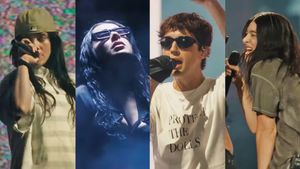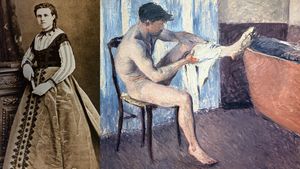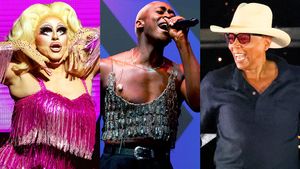There's a LGBT movement happening, not at the voting booth but at the box office: A quiet revolution that may be more threatening to far-right wingnuts than thought possible. It's kids' movies. From ParaNorman to Frozen, animated films aimed at children (but also enjoyed by adults) are shaping how kids think about LGBT issues without ever uttering the word "gay." The latest threat: The Boxtrolls.
It remains to be seen just how great this new animated film will be when it's released Sept. 26, but the damage (or rather, the benefit) may have already been done. When the film's studio, Laika -- the team behind ParaNorman and Coraline -- started promoting the film, they did so with a trailer that showed the many types of families that kids can have today (although the humans are all wearing Victorian garb).
A narrator intones: "Sometimes there's a mother. Sometimes there's a father. Sometimes there's a father and a father. Sometimes both fathers are mothers." Eventually we see the little boy's "real" family in this film--the titular little creatures in crates -- and the narrator says, "But sometimes, there are boxes," concluding that "families come in all shapes and sizes, even rectangles."
In a political landscape where marriage equality and same-sex parenting are becoming pop culture standards (think Lily and her fathers on Modern Family), this may seem an innocuous message. But placing a pro-gay message in the trailer for a children's film? Most social media experts agree that's ballsy, even today, and it courts as much conservative backlash as it does LGBT viewers.
Of course for Laika, the Oregon-based animation studio owned by Nike chairman Phil Knight, the gay rights message was an easy choice. Knight and Nike have been vocal supporters of LGBT rights, and Knight's son, 39-year-old animator Travis Knight, the CEO and president of Laika, told the Hollywood Reporter that it was a values issue for the company.
"We're not in any way trying to be activists. We're just trying to be who we are," he said. "There are going to be people who simply don't agree with that and we understand, but we also won't flinch from the consequences of that. The kinds of films we make have to be consistent with our values and how we look at the world, and sometimes that means putting yourself out there a little bit."
While the film's trailer pushes the envelope, it should also bring in the right kind of moviegoers, those who are drawn to the 3-D stop-motion and CG hybrid animated feature based on the best-selling kid's fantasy adventure novel Here Be Monsters! by Alan Snow; the same reasons they came to watch Coraline or ParaNorman, both of which risked backlash from social conservatives.
The trailer for The Boxtrolls is the most recent in a wave of animated children's films that are changing America's feelings about LGBT people and the families they form, perhaps as much as any legislation ever will, and regardless of the film's end product the studio behind it can be credited for taking that wave to new heights with this trailer. After all, ParaNorman, the last Laika film, was the first mainstream American animated children's film to have an out gay character (and a handsome teenage boy to boot!). This past summer, animation giant DreamWorks released How to Train Your Dragon 2, which featured a character's coming out, albeit a subtle one, thanks to an ad lib from voice actor Craig Ferguson.
Surely ParaNorman's Mitch wasn't the first gay character in kids' animation; ask any grown-up queer and they'll offer a list of characters that even in their childhood they thought were sort of, you know, gay. Or trans. Or bi. Velma on Scooby-Doo and Gosalyn on Darkwing Duck were long assumed to be lesbian; Mystique of the X-Men is bisexual, though the kids' TV series never mentions it. Chip and Dale and The Lion King's Timon and Pumba got read as gay couples; and because he was openly fey and spoke with a distinctive idiom, almost every character Paul Lynde voiced on '70s shows like Where's Huddles? and Hanna-Barbera's The Perils of Penelope Pitstop at least sounded gay.
Starting in the '90s, many Japanese anime films had characters that were clearly transgender, bisexual, or gay -- from Dragon Ball Z to Pokemon -- but they were all neutered when the shows were dubbed for American audiences. The most egregious example of this is Sailor Moon, in which a lesbian couple, Sailor Uranus and Sailor Neptune, was rewritten as cousins -- very, very close cousins. (This shift generally confused kids more than lesbians would have.)
The same series boasted what might be the first transgender characters in an animated children's show: the Sailor Starlights, three singers who were in male bodies during "civilian" times and in women's bodies when it was time to do battle. In the Italian version of the show, producers pretended there were simply six different people; in Korea, the characters were women full-time and in Russia they were men -- no matter what their bodies looked like that day. While Mexico and Brazil kept the transgender characters as they originally appeared, several countries, including the United States, never even saw the season with the Starlights. Debate around whether that's because the rights were not available or because the trans characters were considered too risque for America's children continues to this day among fans.
Traditionally, American-made animated films for children have taken more circuitous routes to offer subversive LGBT characters or themes, such as 2001's Shrek with its messages about self-acceptance (Fiona's size/image), nontraditional relationships, (Donkey and Dragon), and against bullying (meanie Lord Farquaad). It, too, was a film that both kids and adults enjoyed, with its sprinklings of sarcasm, modern music, and references aimed squarely at those in the know. In 2008, Wall-E did much the same, as did 2009's Coraline, based on Neil Gaiman's book, which featured one of those female duos that live together and are often a thinly veiled lesbian couple.
 Then came ParaNorman, a film where a dumb but handsome jock has a boyfriend. We find this out not in a whoppingly emotional coming-out scene but as an aside, and then the narrative -- itself rife with themes of relevance to LGBT youth and their acceptance -- goes on. This no-big-deal treatment of homosexuality simply reflects how young people themselves feel about sexual orientation and, sometimes (perhaps to a lesser extent) even gender identity and expression.
Then came ParaNorman, a film where a dumb but handsome jock has a boyfriend. We find this out not in a whoppingly emotional coming-out scene but as an aside, and then the narrative -- itself rife with themes of relevance to LGBT youth and their acceptance -- goes on. This no-big-deal treatment of homosexuality simply reflects how young people themselves feel about sexual orientation and, sometimes (perhaps to a lesser extent) even gender identity and expression.
Much talk this past year was centered on Frozen, the Disney princess film in which the girls do the rescuing and have all the power. Its only lame love story is actually a small segue to poke fun at Disney traditions, and the main theme that comes through -- not subversively, but so overtly that it's part of the soundtrack -- is self-acceptance of who you really are. And yes, that promotes gay (and bi and trans and black and adopted and so on) rights.
Beyond what's been said at length about the progressive, smart parts of Frozen, the fact that its hunky and feminist male character, Kristoff, was also raised by trolls compounds the underlying message of The Boxtrolls' trailer: families come in all shapes and sizes. In this, hysterical Christian conservatives were right: Frozen, like ParaNorman, Coraline, and most likely The Boxtrolls, is most certainly a film promoting LGBT issues. But these films' themes of acceptance aren't limited to gay or transgender people.
This new crop of kids' animated films helps promote the idea not just of tolerance but of celebration of same-sex parents, multiracial families, adopted children, families of choice and more. That human kids in both The Boxtrolls and Frozen have troll parents is likely a coincidence, but one that reminds you that filmmakers, playwrights, and smart studios like Laika know that it's the kids themselves who are eager to see concepts of acceptance, tolerance, and difference play out on screen.
It's also proof that, in many ways, these animated kids' films can do as much -- or more -- to change Americans' prevailing feelings about LGBT people as films like Dallas Buyers Club and The Normal Heart ever could, by mainstreaming ideas about diversity in real, practical, and entertaining ways to children. And they do so using voice actors we know, recognize, and respect, thus validating the message all the more.
Will The Boxtrolls be railed against for "pushing a gay agenda?" Probably. But that won't stop kids--and their parents--from enjoying it.
Images courtesy of Focus Features

































 Then came ParaNorman, a film where a dumb but handsome jock has a boyfriend. We find this out not in a whoppingly emotional coming-out scene but as an aside, and then the narrative -- itself rife with themes of relevance to LGBT youth and their acceptance -- goes on. This no-big-deal treatment of homosexuality simply reflects how young people themselves feel about sexual orientation and, sometimes (perhaps to a lesser extent) even gender identity and expression.
Then came ParaNorman, a film where a dumb but handsome jock has a boyfriend. We find this out not in a whoppingly emotional coming-out scene but as an aside, and then the narrative -- itself rife with themes of relevance to LGBT youth and their acceptance -- goes on. This no-big-deal treatment of homosexuality simply reflects how young people themselves feel about sexual orientation and, sometimes (perhaps to a lesser extent) even gender identity and expression.

















































Fans thirsting over Chris Colfer's sexy new muscles for Coachella